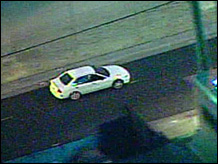RESEARCH A CAR
Get invoice and market prices, specs, reviews and photos
GET A QUOTE
RESEARCH A USED CAR
Get used car pricing, reviews, ratings, and more.
|
|
|
|
|
|

|
| A California highway-patrol officer was injured when his car slammed into a wall during a car chase. |
Play video
|
|
|
|
NEW YORK (CNN/Money) -
If you've ever watched a live broadcast of a police chase filmed from a news helicopter, several thoughts may have occurred to you. Among them:
"Man, this is boring."
"When are the cops going to do something?"
and finally...
"Where are the cops, anyway?"
Unlike fictional police chases on TV and in the movies, real chases rarely get too exciting. If they do, it usually means that something has gone terribly wrong.
Driving a police car under any circumstances is a difficult and dangerous business, said Capt. Travis Yates of the Tulsa, Ok. police department. Yates moderates the Policedriving.com Web site and writes a regular column on police driving for the Web site PoliceOne.com.
The inside of a modern police car is filled with complex electronic devices that many would find difficult to use even if they were seated at a desk. Operating a police radio, for example, would tax many driver's attention even under normal circumstances.
The distracting nature of the job is a major reason, Yates said, that far more police officers die in traffic accidents than in shootings.
Dangerous pursuits
When it comes to chasing bad guys, two things are critical, said Yates: Training and a clear policy.
Training in many police departments, particularly smaller ones, is sorely lacking, said Yates.
A high-speed chase, he said, is one of the few times when police officers will knowingly put the lives of innocent civilians at risk.
"In a police pursuit, everyone on the road at that given time is now in danger," he said.
Because of the high risk, many municipalities now ban chases except in cases where the suspect is clearly dangerous and cannot be apprehended any other way.
The decision
The first part of any police chase is the decision to go after the suspect rather than just let them go. A host of factors go into that decision.
What's the crime? If the suspect snatched a purse, it's certainly not worth risking people's lives to go get him. If he shot up a grocery store, that's another story. If police have identified the suspect, they may decide simply to track him down later.
When is it? If it's the middle of the afternoon and the streets are crowded, police would be much more reluctant to start a chase. If it's the middle of the night and the roads are empty, the risk might be low enough.
Weather If it's raining or snowing, the chances of a crash are greatly increased.
Once officers start a chase, one of the first things they would do would be to radio in the location, speed, vehicle description and the reason for the chase.
In most cases, a supervisor would get on the radio and make a decision on how to proceed. If chase gets out of hand, the supervisor can call it off at any time.
Once a chase begins, it's important to have someone who is not actively involved in the pursuit making those sorts of decisions, said Yates. The officer driving the police car will tend to want to keep going no matter what.
Ending the chase
Options for safely ending a police chase are fairly limited. There are high-tech devices that use high-intensity radio waves to shut off a car's engine. But those devices are far too expensive for most police departments, Yates said.
Devices that puncture a vehicle's tires are much less expensive, but can only be used in places where no other cars are likely to be driving.
Using police cars to block the suspect's vehicle is extremely risky and not effective in cases where the suspect is, so to speak, highly motivated. A police car can easily be rammed or pushed out of the way.
A maneuver that is euphemistically known as the "Pursuit Intervention Technique" can be useful under the right circumstances and when executed by a well-trained officer, Yates said.
The PIT involves deliberately driving the police car into a rear corner of the fleeing vehicle. Properly done, this forces the vehicle to spin and come to a stop. It can only be used in places where there are no other vehicles around and where there are no curbs that might cause the suspect vehicle to flip over.
If the police department has access to a helicopter, that changes things a lot. Since the vehicle can be tracked from the air, police cars don't have to keep the suspect vehicle in sight.
Instead they can hang back or drive on parallel roads, out of sight. Most suspects, once they feel they are no longer being chased, will stop someplace and get out of the car.
Then you can nab them.
Feedback

|